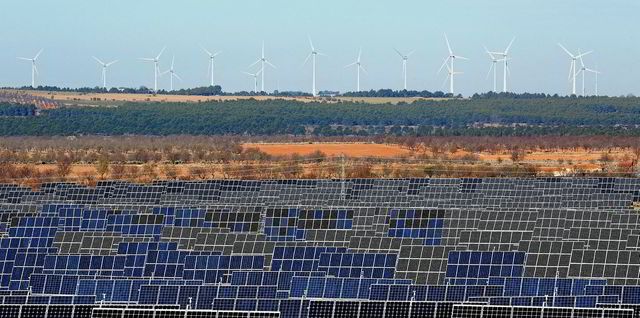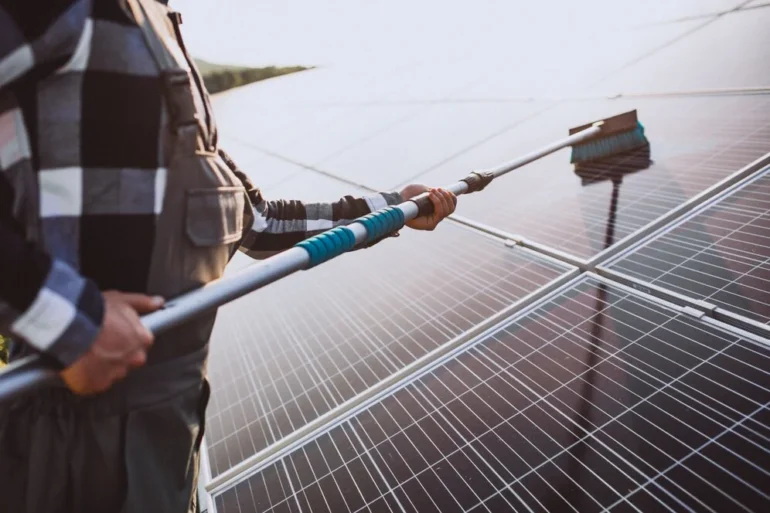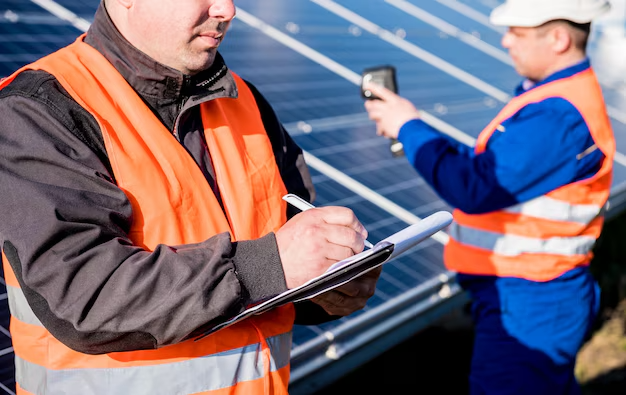Solar PV is Australia’s cheapest new source of renewable energy and solar outshines wind energy for the lead in the country’s clean energy transition. Solar PV capacity is expected to triple nearly by 2022, reaching more than 5.5 gigawatts (gW) – mostly on rooftops of homes, schools, and businesses – while wind farms will grow to around 3 gW. This article explains why solar has momentum, the implications for investors and suppliers, and what it all means for Australia’s future.
In Australia’s transition towards a cleaner and more sustainable energy future, solar power has emerged as the leading source of clean energy, surpassing wind energy in recent years. The country’s abundant sunlight, favorable geographic conditions, and continuous technological advancements have propelled solar energy to the forefront of Australia’s clean energy revolution.
Why solar is leading the clean energy transition in Australia
Solar PV has won the race to become Australia’s cheapest new source of renewable energy, solar outshines wind energy in the country’s clean energy transition. Solar PV capacity is expected to triple nearly by 2022, reaching more than 5.5 gigawatts (gW) – mostly on rooftops of homes, schools, and businesses – while wind farms will grow to around 3 gW. This significant transition can be attributed to falling costs of solar PV, the change of focus from large-scale to small-scale projects, the growing competition in the wind sector, and increased investment in the solar sector. As a result of these factors, solar is now projected to be Australia’s cheapest source of new renewable electricity, ahead of wind and other renewable sources such as hydro and biomass. Solar PV’s cost advantage over wind in Australia is expected to increase over time as more solar PV is built and installed.
Falling costs of solar PV will continue to drive adoption
Solar PV has experienced a dramatic fall in costs since the first panels were installed in Australia in the mid-1970s. The price of solar PV has fallen by more than 80% since 2015, making it the cheapest source of new power generation. Electricity generation from solar PV has become even cheaper in recent years as more high-efficiency, low-cost panels have come onto the market, along with lower financing costs and increased competition in solar project development. The latest generation of panels has a levelised cost of electricity (LCOE) of between AUD $0.06 and $0.08/kWh, making it significantly cheaper than new wind farms, which have an LCOE of between AUD $0.06 and $0.10/kWh. The continued reduction in the cost of solar PV is expected to drive its uptake across Australia and the world, particularly in the utility-scale segment, where developers are increasingly selecting solar PV to meet utility minimum renewable energy procurement targets.
Businesses are recognizing the benefits of going solar
Solar PV is increasingly being adopted by businesses, including large retailers and small-to-medium enterprises (SMEs), to lower their energy costs, optimize their energy portfolio, and manage their carbon emissions. Solar PV is enabling businesses to cut their energy bills, become more resilient, save time and money on grid management, and achieve positive publicity through pledging to go 100% renewable. In Australia, around 4% of the country’s commercial sector is on solar PV, and this is expected to reach around 12% by 2028. Most commercial solar customers are not on a power purchase agreement but instead, own their systems outright or use a low-cost financing option, such as a third-party loan. Australian businesses have already saved more than AUD $6 billion from going solar, and this is projected to increase to AUD $13.2 billion by 2030.
Supply chain implications for Australia
Solar PV’s rise to become Australia’s cheapest new source of renewable energy will impact key supply chain industries, including polysilicon, silicon, modules, engineering, procurement and construction (EPC), and balance of plant (BOP). Demand for polysilicon has been slowing since the start of the decade as the world has built up large inventories of silicon. Still, this trend may reverse as new demand emerges from the Asia-Pacific region. Silicon prices are likely to rise as production ramps up to meet the growing demand for solar panels. There has been a shift from China to Taiwan as the dominant silicon producer. Polysilicon prices are expected to increase as demand for solar continues to rise, but this will be tempered by the increase in silicon demand, which could curtail the price rise of polysilicon. Modules account for about 50% of the total cost of a solar installation, so any change in the price of modules will have a significant impact on the LCOE. The EPC industry has been the main beneficiary of the rise in solar PV, with demand forecast to increase by 85%.
Implications for investors and suppliers
Solar PV’s rise to become Australia’s cheapest new source of renewable energy comes at a time of increased focus on climate risk by investors. This trend is expected to continue as investors and governments around the world put pressure on energy companies to reduce emissions and move towards cleaner forms of energy. This will create new investment opportunities in the solar sector, particularly in rooftop solar systems, along with opportunities for solar module manufacturers to expand their business. Renewable energy project developers and asset owners are also expected to benefit from the increasing demand for solar PV, particularly utilities required to procure a certain percentage of electricity from renewable sources. The rise of solar PV will also provide opportunities for third-party financing providers and banks, which are already financing solar projects, to expand their business.
Abundant Solar Resources
Australia is blessed with vast expanses of land and receives abundant sunshine throughout the year. This makes solar energy an abundant and readily available resource in most parts of the country, allowing for the efficient harnessing of solar power.
Falling Solar Costs
Over the past decade, the cost of solar photovoltaic (PV) systems has significantly decreased, making solar energy more affordable and cost-competitive compared to other renewable energy sources. The declining costs of solar panels, improved efficiency, and economies of scale have made solar installations a financially attractive option for businesses and households alike.
Rapid Technological Advancements
Australia has been at the forefront of solar energy research and development, fostering innovations in solar panel technology, energy storage solutions, and grid integration. These advancements have improved the efficiency and performance of solar systems, making them more reliable and effective in meeting the country’s energy demands.
Rooftop Solar Boom
Australia has experienced a significant surge in rooftop solar installations, with millions of households and businesses adopting solar power systems. This decentralized approach empowers individuals to generate their own clean energy, reducing reliance on centralized energy infrastructure and promoting energy independence.
Supportive Government Policies
The Australian government has implemented various supportive policies and incentives to encourage the growth of solar energy. This includes financial incentives such as solar rebates, feed-in tariffs, and net metering schemes that make solar installations more financially viable for consumers and businesses.
Environmental Benefits
Solar energy offers substantial environmental benefits, including reduced greenhouse gas emissions, improved air quality, and conservation of natural resources. The transition towards solar power aligns with Australia’s commitment to mitigating climate change and achieving its renewable energy targets.
Scalability and Flexibility
Solar energy systems can be easily scaled up or down to meet different energy demands, making them suitable for diverse applications ranging from large-scale solar farms to residential installations. This scalability and flexibility contribute to the widespread adoption of solar energy across various sectors in Australia.
Job Creation and Economic Growth
The rapid expansion of the solar industry in Australia has created numerous job opportunities across the value chain, from manufacturing and installation to maintenance and operation. The growth of the solar sector also stimulates economic activity and attracts investments, contributing to overall economic growth.
Reliability and Predictability
Solar energy generation is predictable and reliable, with well-established forecasting techniques that enable effective grid integration and management. The predictability of solar power generation helps ensure grid stability and facilitates the integration of other renewable energy sources into the energy mix.
Community Engagement and Ownership
Solar energy projects, particularly community-owned initiatives, foster local engagement and ownership in the clean energy transition. Community solar projects empower individuals and communities to participate actively in the generation and consumption of clean energy, fostering a sense of sustainability and shared responsibility.
Conclusion
Solar PV has won the battle to become Australia’s cheapest new source of renewable energy, outshining wind energy to lead the country’s clean energy transition. Solar PV’s fall in costs and its increased adoption is expected to continue to drive its share of the renewables market. Solar PV’s rise to become Australia’s cheapest new source of renewable energy comes at a time of increased focus on climate risk by investors. This trend is expected to continue as investors and governments around the world put pressure on energy companies to reduce emissions and move towards cleaner forms of energy. This will create new investment opportunities in the solar sector, particularly in rooftop solar systems, along with opportunities for solar module manufacturers to expand their business.
FAQs about solar energy
Is solar energy reliable?
Yes, solar energy is reliable. While solar power generation is dependent on sunlight, advancements in technology and the integration of energy storage systems have made solar energy more consistent and reliable, even during periods of low sunlight or cloudy weather.
How long do solar panels last?
Solar panels have a lifespan of around 25 to 30 years. With proper maintenance and regular cleaning, solar panels can continue to generate electricity efficiently throughout their lifespan.
Can solar panels work during a power outage?
Most solar energy systems are grid-tied, meaning they are connected to the electrical grid. In the event of a power outage, these systems automatically shut down to prevent backfeeding and protect utility workers. However, with the addition of energy storage solutions, such as batteries, solar panels can still provide electricity during power outages.
Do solar panels require a lot of maintenance?
Solar panels are relatively low-maintenance. Regular inspections to ensure panels are clean and free from debris, as well as occasional checks on the system’s performance, are recommended. Other than that, solar panels require minimal maintenance and can operate efficiently for many years.







